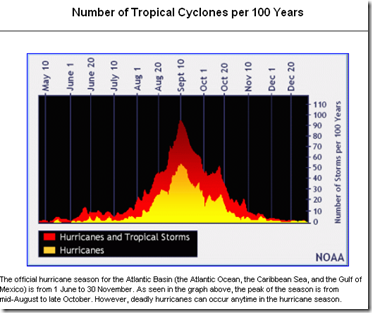#14,232
NOAA issues an Atlantic Tropical Outlook in late May, before the start of Hurricane season (see NOAA predicts near-normal 2019 Atlantic hurricane season), followed by an updated outlook in the first week of August.
This pre-season outlook called for 9 to 15 named storms, 4 to 8 hurricanes, and 2 to 4 major hurricanes.While the Atlantic Hurricane season has been pretty quiet so far (1 subtropical storm in May, and CAT 1 hurricane Barry in the Northern Gulf in mid July), we often don't start seeing a lot of development until mid-to-late August (see graphic below).
Category 5 Hurricane Andrew - the first named storm of 1992 - didn't form until August 16th, but devastated parts of South Florida in what was otherwise a below average hurricane season.
A reminder that even a modestly active season can produce life-altering, catastrophic damage.Today NOAA has updated their outlook, and with El Nino dissipating in the Pacific - a trend which favors more development in the Atlantic - they are upping their forecast for the remaining 4 months of the 2019 season.
Excerpts from today's press release follow:
NOAA increases chance for above-normal hurricane season
The end of El Nino could boost Atlantic hurricane activity
August 8, 2019 NOAA forecasters monitoring oceanic and atmospheric patterns say conditions are now more favorable for above-normal hurricane activity since El Nino has now ended. Two named storms have formed so far this year and the peak months of the hurricane season, August through October, are now underway. (SNIP)
Seasonal forecasters with NOAA’s Climate Prediction Center have increased the likelihood of an above-normal Atlantic hurricane season to 45% (up from 30% from the outlook issued in May). The likelihood of near-normal activity is now at 35%, and the chance of below-normal activity has dropped to 20%.
The number of predicted storms is also greater with NOAA now expecting 10-17 named storms (winds of 39 mph or greater), of which 5-9 will become hurricanes (winds of 74 mph or greater), including 2-4 major hurricanes (winds of 111 mph or greater). This updated outlook is for the entire six-month hurricane season, which ends Nov. 30.
NOAA is also announcing today that the current El Nino in the Pacific Ocean has ended and neutral conditions have returned. “El Nino typically suppresses Atlantic hurricane activity but now that it’s gone, we could see a busier season ahead,” said Gerry Bell, Ph.D., lead seasonal hurricane forecaster at NOAA’s Climate Prediction Center.
(Continue . . . )
For more than 50 million Americans living in coastal areas, hurricanes and their byproducts (flooding, tornadoes, lightning) are probably their greatest natural disaster threat.
If you live anywhere in `hurricane country' and haven't done so already, now is a good time to visit NOAA's Weather-Ready Nation 2019's Hurricane Preparedness week web page, and decide what you need to do now to keep you, your family, and your property safe during the coming tropical season.
Following last October's Category 5 Hurricane Michael, which battered the Florida Panhandle and parts of Georgia, the Carolinas, and Virginia, this year Floridadisaster.org is recommending a minimum of a 7 day supply. And I'm sure they wouldn't be unhappy to see you extend that to 14 days.
Disaster Supply Kit
Ensure you and your family are prepared before the next disaster impacts your community. Following an emergency or disaster, you may lose access to basic services, such as power and water, and be subject to limited or no access to essentials like food and water.
With that in mind, stock up on essentials now and build a disaster supply kit to last you and your family for a minimum of 7 days.
Each individual or family disaster supply kit will differ based on personal needs. Review the list below to help you get started on basic items to include in your kit. Assess your individual and family needs to determine other critical items to include.Floridadisaster.org goes on to list the items you will need.
As many residents of Florida learned the hard way in September of 2017 - you need to be prepared before a threat appears imminent - as there wasn't a flashlight, candle, or battery left on the shelves a full four days before the arrival of hurricane Irma.
Natural disasters often boil down to unscheduled camping - for days, or
sometimes weeks - in your home, at a friends house, in a community shelter, or possibly even in
your backyard.
Admittedly, some of the items in this list are more for comfort and convenience, than for survival.
If you think of preparedness that way, it becomes far less daunting.Each year I curate a list of low-cost `camping' (aka `preparedness') items that I have, or have given as gifts to friends and family (see The Gift Of Preparedness - Winter 2018).
Admittedly, some of the items in this list are more for comfort and convenience, than for survival.
But the physical and psychological impacts stemming from the hardships following a disaster are real (see Post-Disaster Sequelae), and a modicum of creature comforts can go a long ways towards mitigating their effects.While being prepared doesn't guarantee you a good outcome during and after a disaster, it significantly improves your chances.



